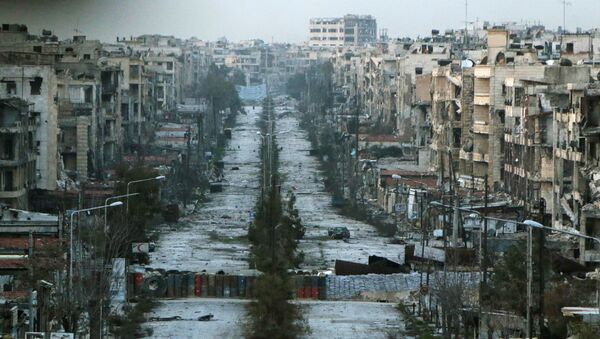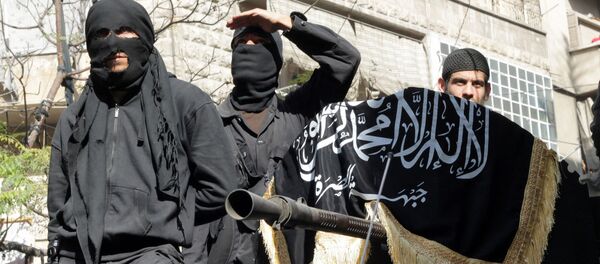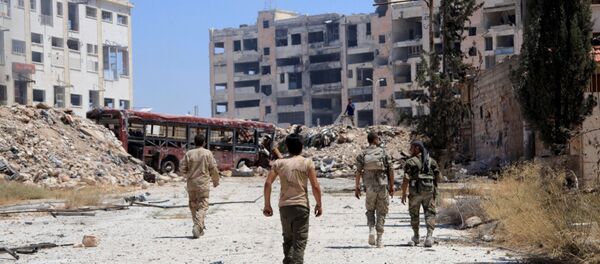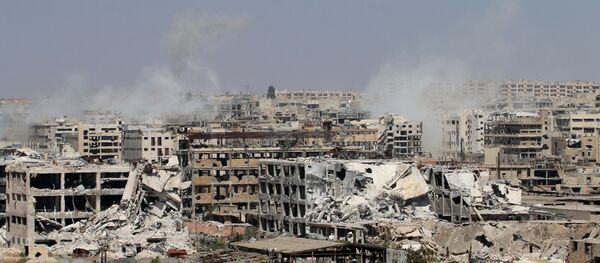On Thursday, Russian Defense Minister Sergei Shoigu announced that Moscow and Damascus has launched a massive humanitarian operation in Aleppo, establishing exit routes for civilians and any militants wishing to leave the jihadist-held portions of the city. Three routes were designated for civilians, along with a fourth for militants with weapons and equipment.
In accordance with the humanitarian operation, the Russian Defense ministry has called on the Syrian government to guarantee amnesty for those militants who choose to voluntarily lay down their arms, so long as they do not belong to groups accused of war crimes. In turn, Syrian President Bashar Assad issued a decree providing amnesty for all armed parties, if they surrender and lay down their arms, and release any persons who are being forcibly held. The amnesty will be valid for a three month period.
The Syrian Air Force has also begun dropping leaflets calling on militants to surrender their weapons and leave the city through the specially designated routes.
Earlier this month, assisted by Russian air support, the Syrian Army succeeded in cutting off the main route used by insurgents in the north and eastern quarters of the city. On July 28, the Syrian Army continued their advance through the outskirts of Aleppo, liberating the areas of Bani Zaid and Layramun. At the same time, Kurdish YPG forces successfully dislodged militants from an Aleppo youth housing complex, adjacent to the Kurdish quarter of Sheikh Maqsood, thus helping to form a tight ring around the insurgent-held areas.
The journalist recalled that "according to Western analysts, the surrounded territory is populated by about 270,000 civilians and 10,000 opposition militants. It's up in the air whether or not they will agree to leave" the city.
At the same time, liberating a large urban area takes a great deal of time and military resources. "For example, the Kurdish-Arab Syrian Democratic Forces alliance, with US support, has been storming the city of Manbij for two months, having surrounded it in a tight ring, and even cut it into two enclaves. But the Daesh militants are holding, and even forcing the Kurds into negotiations, given the heavy losses taken by their troops. Manij, by its size and density, can't be compared to the Aleppo pocket, and has significantly fewer militants."
Asked to comment on the military operation to free the city and the parallel large-scale humanitarian operation, CIS Institute deputy director Vladimir Evseyev suggested that the latter effectively serves as a preemptive measure, aimed at disarming Western critics talking about a humanitarian disaster in Aleppo once the military operation heats up.
At the same time, Evseyev added that hopefully, "the provision of a corridor for insurgents will help to minimize losses among both civilians and the Syrian Army, which will also be mauled in case of a sweep through the city. After all, militants actively use civilians as human shields, and use snipers, mines and improvised explosive devices as well."
At the same time, he said, "some reports have indicated that the Syrian Army has concentrated artillery units in the area. We should probably also expect active operations by the Russian Aerospace Forces and the Syrian Air Force."
Ultimately, the analyst noted that he is optimistic about the prospects for Aleppo's liberation. "Moreover, President Putin is expected to meet in St. Petersburg with Turkish counterpart Recep Tayyip Erdogan on August 9. In this connection, we can assume that active support for the militants from Turkey will not be forthcoming."
For his part, independent military expert Anatoly Nesmiyan suggested that the operation to provide civilians and fighters passage out of the city is an indication that strategists are actively working to try to find a solution to the problem without storming the city, since they understand that clearing the city of militants will be difficult and costly.
"The pocket, in addition to civilians, has about seven to ten thousand fighters, who will fight desperately, hiding behind civilians as they do so. It's not necessary to look far for a similar example," Nesmiyan noted, pointing to the painfully slow operation to liberate Manbij. "And this is the case despite the fact that unlike Syrian troops, SDF forces are not dispersed along several fronts."
Unfortunately, Nesmiyan noted that he does not expect militants to accept the offer any time soon. "On the contrary, they'll likely reject it. As a result, a situation similar to the one in Manbij may develop. There, the Kurds offer the militants the opportunity to leave the city for the Daesh capital of Raqqa what seems like every other day, but they refuse. Subsequently, [in Aleppo] too the situation can get hung up for a long time."
The analyst pointed out that even isolated pockets of militants can hold out for a very long time. Effectively, Islamist militants in both Iraq and Syria have been resisting in pockets for years at a time.
Ultimately, Nesmiyan suggested that everything will depend on how many units take up the government's offer to surrender or withdraw. In any case, "losing Aleppo is not something the opposition wants to do. There will probably even be attempts made to break through the blockade from the outside. For example, three weeks ago, groups from the Salafist Jaish al-Fatah coalition broke through a portion of the Castello Highway, thus managing to get several thousand fighters out of Latakia."
Finally, Semyon Bagdasarov, the director of the Center for the Study of the Middle East and Central Asia, suggested that he believes that militants are likely to dig in, rather than leave Aleppo. Worse yet, "it's obvious that the militants will also discourage the civilian population from leaving…since they use them as human shields in their defensive operations."
The analyst also warned that wide holes in the Turkish-Syrian border continue to exist, and suggested that the flow of militants and equipment from Turkey is thus set to continue. "In addition, the US too remains watchful, having again offered a seven day ceasefire recently. It's obvious that this would be used for the redeployment of terrorists and the regrouping of forces."







